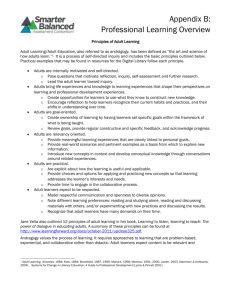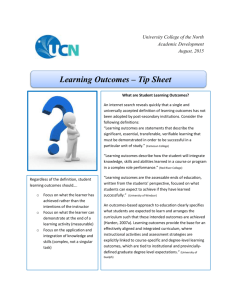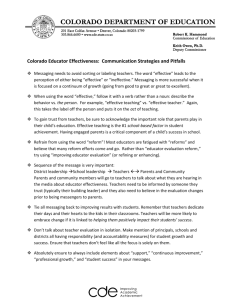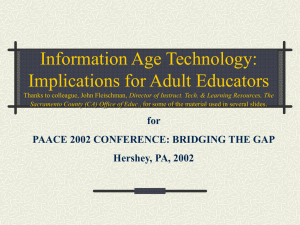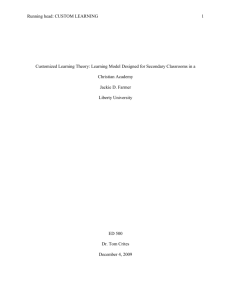Portfolio 4.3: Encouraging Students to Extend Their Thinking
advertisement
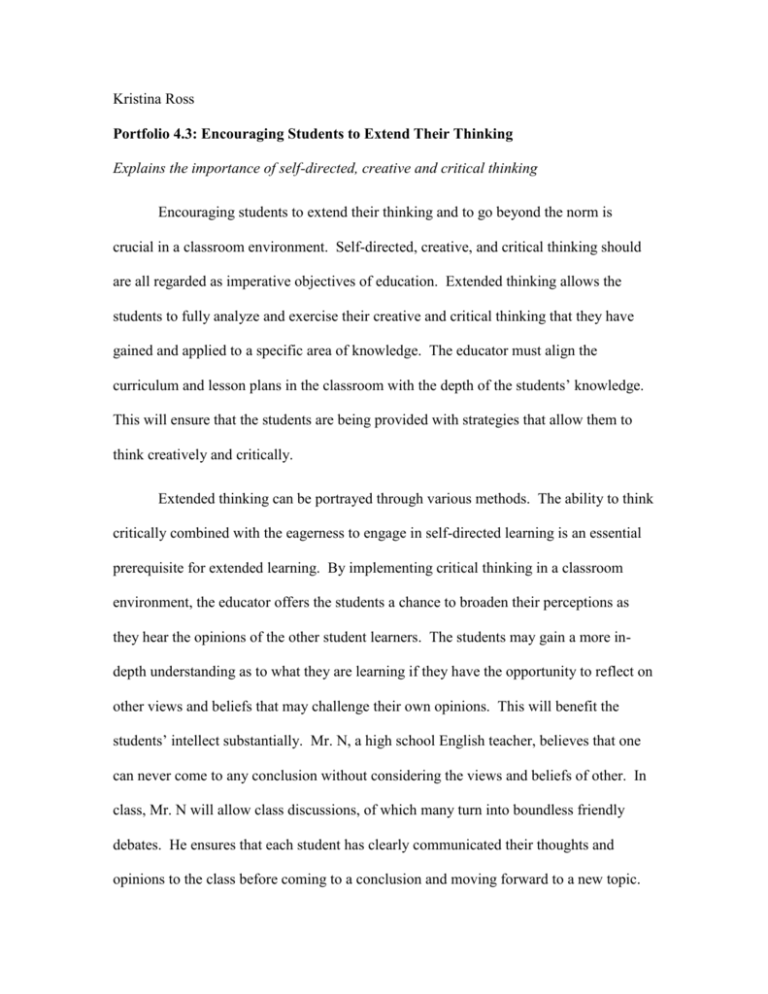
Kristina Ross Portfolio 4.3: Encouraging Students to Extend Their Thinking Explains the importance of self-directed, creative and critical thinking Encouraging students to extend their thinking and to go beyond the norm is crucial in a classroom environment. Self-directed, creative, and critical thinking should are all regarded as imperative objectives of education. Extended thinking allows the students to fully analyze and exercise their creative and critical thinking that they have gained and applied to a specific area of knowledge. The educator must align the curriculum and lesson plans in the classroom with the depth of the students’ knowledge. This will ensure that the students are being provided with strategies that allow them to think creatively and critically. Extended thinking can be portrayed through various methods. The ability to think critically combined with the eagerness to engage in self-directed learning is an essential prerequisite for extended learning. By implementing critical thinking in a classroom environment, the educator offers the students a chance to broaden their perceptions as they hear the opinions of the other student learners. The students may gain a more indepth understanding as to what they are learning if they have the opportunity to reflect on other views and beliefs that may challenge their own opinions. This will benefit the students’ intellect substantially. Mr. N, a high school English teacher, believes that one can never come to any conclusion without considering the views and beliefs of other. In class, Mr. N will allow class discussions, of which many turn into boundless friendly debates. He ensures that each student has clearly communicated their thoughts and opinions to the class before coming to a conclusion and moving forward to a new topic. Mr. N will also play devil’s advocate in the sense that he wants to make sure that each side is heard and considered. By encouraging the students to envision more than one point of view on each subject, he allows the students to analyze all possibilities equally and considerably so that they can come to an educated conclusion based on all scenarios. Describes how higher order thinking stimulates creative and critical thinking Bloom’s Taxonomy was created to categorize and classify levels of intellectual learning that occur most often in classroom settings. It includes learning mechanisms such as knowledge, comprehension, application, analysis, synthesis, and evaluation. These are all vital parts of the learning process that must be implemented to ensure that students’ are attaining the knowledge and criterion to meet their educational needs. Some common methods of incorporating higher order thinking might include brain teasers that are presented to the students at the beginning of each class period or student chosen assignments in which the students are given some independence as they complete an assignment (see evidence). By applying the concept of higher order thinking, the students are more likely to retain information and perform their best on standardized tests. This will help the learner to achieve great outcomes as they prepare themselves to become life-long learners. The levels of Bloom’s Taxonomy are precisely distinguished by the differentiation of student learners and their ability to adapt to particular classroom methods. Each student is capable of achieving great successes, though each individual learner has their own skills and techniques that are used to create a higher order of thinking that can be used to their advantage. This higher order thinking extends not only the students’ knowledge base, but also extends their willingness and perceived capabilities towards specific instructional procedures. Bloom’s Taxonomy makes higher order thinking possible while ensuring that educators are presenting curriculum and lesson plans that relate to the students and their capabilities in a creative and critical way. Demonstrates how technology can be used to extend student thinking Technology can be used through various methods to extend student thinking. The educator must have a variety of ways to introduce material that will make the students want to learn and extend their thinking. Mrs. W always encourages her English class to broaden their horizons by extending their thinking. Often times, she uses technology to do so. For each vocabulary unit, she would create a PowerPoint presentation with a slide for each individual word. The slide would include the vocabulary word along with a picture that helps her, individually, to remember the word and it’s meaning. When her presentation was finished, Mrs. W would have each student prepare twenty index cards with one vocabulary word on each card. The students would then be instructed to find a picture on the Internet that helped them to remember the word along with its definition. Clearly, this was a creative thinking activity that helped each student to retain the information in a way that was beneficial to them and their individual learning processes. Ultimately, encouraging students to extend their thinking can be a tedious task at times, but it is well worth the while. The students must also put in a great amount of time and effort to ensure that they have the tools to reach a higher order of thinking. They must apply themselves accordingly so that the educator can create an environment where each individual student can stimulated through creative and critical thinking procedures. As the students develop higher order thinking, they will realize the importance of selfdirected, creative and critical thinking. Integrating these levels of intellect into the classroom will help students improve in all content areas. The incorporation of higherlevel instruction and higher order thinking in the classroom will provide the educator with a quicker, easier route for aligning the curriculum and lesson plans with the students’ educational capabilities and will make for an intellectually well-rounded student learner.
